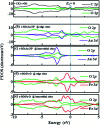A review on the use of DFT for the prediction of the properties of nanomaterials
- PMID: 35480718
- PMCID: PMC9037996
- DOI: 10.1039/d1ra04876g
A review on the use of DFT for the prediction of the properties of nanomaterials
Abstract
Nanostructured materials have gained immense attraction because of their extraordinary properties compared to the bulk materials to be used in a plethora of applications in myriad fields. In this review article, we have discussed how the Density Functional Theory (DFT) calculation can be used to explain some of the properties of nanomaterials. With some specific examples here, it has been shown that how closely the different properties of nanomaterials (such as optical, optoelectronics, catalytic and magnetic) predicted by DFT calculations match well with the experimentally determined values. Some examples were discussed in detail to inspire the experimental scientists to conduct DFT-based calculations along with the experiments to derive a better understanding of the experimentally obtained results as well as to predict the properties of the nanomaterial. We have pointed out the challenges associated with DFT, and potential future perspectives of this new exciting field.
This journal is © The Royal Society of Chemistry.
Conflict of interest statement
The authors declare no conflict of interest.
Figures





























Similar articles
-
Proceedings of the Second Workshop on Theory meets Industry (Erwin-Schrödinger-Institute (ESI), Vienna, Austria, 12-14 June 2007).J Phys Condens Matter. 2008 Feb 13;20(6):060301. doi: 10.1088/0953-8984/20/06/060301. Epub 2008 Jan 24. J Phys Condens Matter. 2008. PMID: 21693862
-
Effects of Strontium incorporation to Mg-Zn-Ca biodegradable bulk metallic glass investigated by molecular dynamics simulation and density functional theory calculation.Sci Rep. 2020 Feb 13;10(1):2515. doi: 10.1038/s41598-020-58789-8. Sci Rep. 2020. PMID: 32054867 Free PMC article.
-
Role of a singlet diradical character in carbon nanomaterials: a novel hot spot for efficient nonlinear optical materials.Nanoscale. 2016 Oct 27;8(42):17998-18020. doi: 10.1039/c6nr06097h. Nanoscale. 2016. PMID: 27722408 Review.
-
Nanomaterial Gas Sensors for Biosensing Applications: A Review.Recent Pat Nanotechnol. 2023;17(2):104-118. doi: 10.2174/1872210515666211129115229. Recent Pat Nanotechnol. 2023. PMID: 34844549 Review.
-
Melt infiltration: an emerging technique for the preparation of novel functional nanostructured materials.Adv Mater. 2013 Dec 10;25(46):6672-90. doi: 10.1002/adma.201301912. Epub 2013 Sep 8. Adv Mater. 2013. PMID: 24014262
Cited by
-
Atomization Energy Calculations in 13-Atom Alkali Metal Clusters: Is There an Appropriate Exchange-Correlation Functional?J Comput Chem. 2025 Jul 30;46(20):e70187. doi: 10.1002/jcc.70187. J Comput Chem. 2025. PMID: 40685886 Free PMC article.
-
Silver Nanoparticles with Mebeverine in IBS Treatment: DFT Analysis, Spasmolytic, and Anti-Inflammatory Effects.Pharmaceutics. 2025 Apr 24;17(5):561. doi: 10.3390/pharmaceutics17050561. Pharmaceutics. 2025. PMID: 40430854 Free PMC article.
-
Interactions of Antibacterial Naphthoquinones with Mesoporous Silica Surfaces: A Physicochemical and Theoretical Approach.Pharmaceuticals (Basel). 2022 Nov 25;15(12):1464. doi: 10.3390/ph15121464. Pharmaceuticals (Basel). 2022. PMID: 36558916 Free PMC article.
-
Mechanosynthesis of Stable Salt Hydrates of Allopurinol with Enhanced Dissolution, Diffusion, and Pharmacokinetics.ACS Omega. 2023 Sep 7;8(37):34120-34133. doi: 10.1021/acsomega.3c05263. eCollection 2023 Sep 19. ACS Omega. 2023. PMID: 37744830 Free PMC article.
-
The Effects of Physical-Chemical Evolution of High-Sulfur Petroleum Coke on Hg0 Removal from Coal-Fired Flue Gas and Exploration of Its Micro-Scale Mechanism.Int J Environ Res Public Health. 2022 Jun 9;19(12):7082. doi: 10.3390/ijerph19127082. Int J Environ Res Public Health. 2022. PMID: 35742330 Free PMC article. Review.
References
-
- Rabouw F. T. and de Mello Donega C., Handbook of Photoactive Semiconductor Nanocrystal Quantum Dots, Springer, 2017, pp. 1–30
-
- Bora T. Dousse A. Sharma K. Sarma K. Baev A. Hornyak G. L. Dasgupta G. Int. J. Smart Nano Mater. 2018;10:116–143. doi: 10.1080/19475411.2018.1541935. - DOI
-
- Demir H. Grabow L. C. ACS Appl. Nano Mater. 2020;3:6127–6130. doi: 10.1021/acsanm.0c01396. - DOI
-
- Segall M. Lindan P. J. Probert M. J. Pickard C. J. Hasnip P. J. Clark S. Payne M. J. Phys.: Condens. Matter. 2002;14:2717–2744. doi: 10.1088/0953-8984/14/11/301. - DOI
-
- Harun K. Salleh N. A. Deghfel B. Yaakob M. K. Mohamad A. A. Results Phys. 2020;16:102829–102840. doi: 10.1016/j.rinp.2019.102829. - DOI
Publication types
LinkOut - more resources
Full Text Sources

